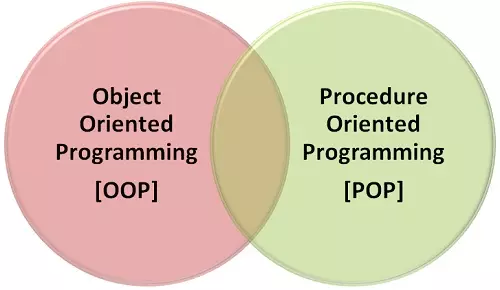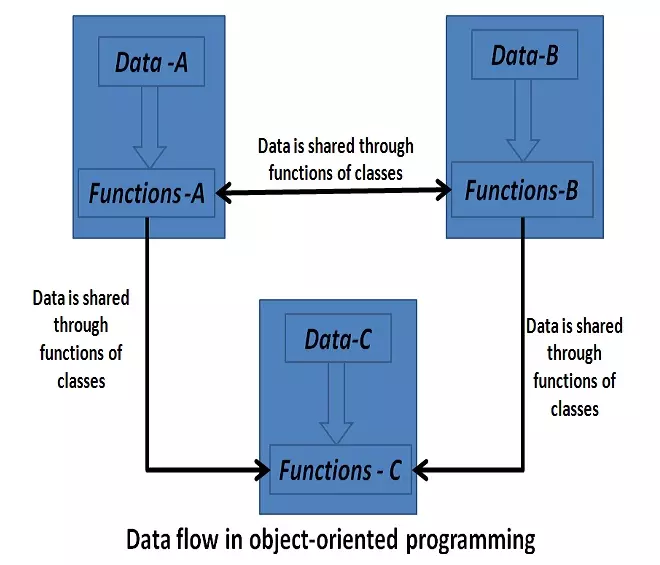Procedure-oriented programming (POP) and Object-oriented programming (OOP) are both programming methods, using high-level languages. A program can be written in both languages, but if the task is very complex, OOP works well compared to POP . In POP , ‘data security’ is at risk when data moving freely in the program, as well as, ‘code reusability’ is not achieved, making programming long and confusing. Large programs lead to more errors and it increases the debug time.
All these errors lead to a new approach, namely object-oriented programming . In object-oriented programming , the main concern is about ‘data security’ which links data closely with previously built-in functions.
OOP also solves the problem of ‘code reusability’ , because if a class is created, many of its instances (objects) can be used to reuse members and member functions defined by a Class.

Comparison chart between OOP and POP
| BASE FOR COMPARISON | POP | OOP |
|---|---|---|
| Basic | Procedure / Structure Orientation. | Object oriented. |
| Approach | From the top down | Bottom up |
| Communication | The main focus is on “how to accomplish the task” ie on the procedure or structure of a program. | The main focus is “data security”. Therefore, only objects are allowed to access the entities of a class. |
| Division | Large programs are divided into units called functions. | The whole program is divided into subjects. |
| Entity access mode | There is no access specifier. | Having intentionally identified access as “public”, “private”, “protected”. |
| Overloading or Polymorphism | Neither it overload functions nor operators. | It overloads functions, constructors, and operators. |
| Inherit | No inheritance support | Inheritance is supported in three states “public”, “private”, “protected” |
| Security | There is no proper way to hide data, so the data is not secure | Data is hidden in three modes “public”, “private”, “protected” so the data security is increased. |
| Data sharing | System-wide data is shared between functions in the program. | Data is shared between objects through functions. |
| Function and Class | There is no concept of Function and Class | Classes or functions can communicate with each other with keywords. (depending on different languages, the keywords will be different) |
| Virtual classes or virtual functions | There is no concept of virtual class | The concept of virtual function appears during inheritance. |
| Languages commonly used | TC, VB, INTRODUCTION, Pascal | C ++, JAVA, VB.NET , C # .NET, Ruby, … |
Definition of object-oriented programming (OOP)
OOP ‘s main concern is how to hide data from functions that are not class objects, which is how it works with important data. Data is closely linked to the functions of a class, operating on it. It does not allow any non-member function to modify the data within it. Objects interact with each other through member functions to access the system’s data.
OOP is developed based on basic concepts of objects, classes, coded or abstract data, inheritance, and polymorphism or overload. In OOP , programs can be divided into modules by partitioning data according to functions, which can be used as additional templates to create new copies of the module, if needed. Therefore, this is an approach that facilitates modularization of programs by building partitioned memory for data and functions.

Object-oriented concept
- Object : It is considered to be an instance of a class.
- Class : It is a collection of objects of the same type. A complete data set and code of an object creates a user-defined data type using a class.
- Data abstraction and packaging: Abstraction is a method of hiding details and showing essential features. Packing is a method of gathering data and functions into a unit.
- Inheritance : Inheritance is a technique of acquiring features of objects from one class to another of class objects. In other words, it helps create a new class from the existing class.
- Polymorphism : Polymorphism provides a method for creating many types of functions using a unique function name.
- Dynamic linking : It determines that the code associated with a particular procedure is not known until the time it is called at run time.
- Message passing: The concept of OOP allows interaction between different classes by transmitting and receiving data.
Procedural-oriented programming (POP)
POP is a common way of programming. Procedure programming is the main focus on completing tasks in sequential order. Flow chart of the program’s control flow. If the program is expanded, it is structured in a number of small units called functions, which share data throughout the system. Here, data security concerns arise, because there is an unexpected change in the program by additional developed functions.
POP characteristics
- While designing a program, POP follows a top-down programming approach.
- Most of the functions allow system-wide data to be shared.
- It also divides larger programs into smaller sections called functions.
- It allows to move data freely around the system.
- Data is converted by functions from one form to another.
The main difference between OOP and POP
- POP is procedural programming while OOP is object-oriented programming.
- The main focus of POP is on how to perform the task of the system, it follows the flow chart to complete the task. The main focus of OOP is data security because only objects of a class are allowed to access the properties or functions of a class.
- Functions are small units of large programs or a subroutine that executes to accomplish the main task. In contrast, the properties and OOP functions of the class are divided among objects.
- In POP , there is no specific access mode to access the properties or functions in the program. In contrast, in OOP, there are three access modes, “public”, “private”, “protected” that are used as an access method to access properties or functions.
- POP does not support the concept of Overloading / polymorphism . In contrast, OOP supports Overload / Polymorphism , which means using the same function name to perform different functions. We can Overload functions, constructors, and operators in OOP .
- There is no inheritance concept in POP, while OOP supports inheritance that allows the use of properties and functions of another class by inheriting it.
- POP is less secure than OOP because in OOP , access assigners restrict access to properties or functions that increase security.
- In POP if some data is shared between all functions in the program, it is declared throughout the system outside all functions. While in OOP , the class data member can be accessed through the class member function.
- There is no concept of virtual classes in POP while in OOP , virtual functions support polymorphism.
Advantages of different types of programming.
POP (Procedural Orientation Programming)
- Provides the ability to reuse the same code in many different places.
- Facilitates the monitoring of program flow.
- Able to build modules.
OOP (Object Oriented Programming)
- Objects help partition tasks in the project.
- Safe programs can be built by hiding data.
- It has the ability to chart objects.
- Lets classify objects into different classes.
- Object-oriented system can be upgraded easily.
- Backup codes can be removed using inheritance.
- Code can be extended by reuse.
- Larger modules can be achieved.
- Data abstraction increases reliability.
- Flexibility due to dynamic binding concepts.
- Separate the necessary specification from the implementation using hidden information.
Conclude
POP vulnerabilities give rise to the need for OOP . OOP was born to overcome POP errors by introducing the concept of objects and classes . It enhances data security and automatically initializes & clears up objects . OOP allows creating multiple versions of the object without any intervention.
Here are my share of 2 programming methods, hopefully through this article you will understand more about OOP and POP. Thank you for watching post sharing.
